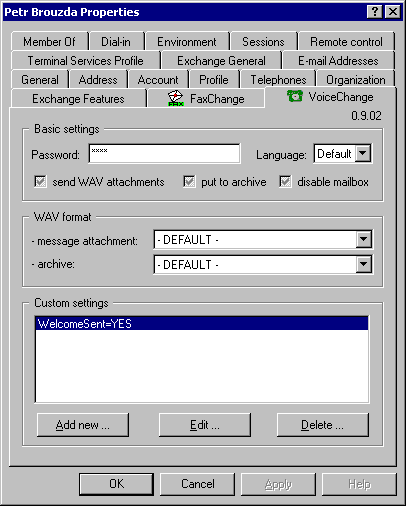|
|
Content of documentation | User documentation | Administrator documentation | Index of terms | Technical Support | Search on-line |
| Administration of MS Exchange users |
Phone number used for VoiceChange routing and message delivering is taken from global address book.
For Exchange 2000/2003 property "Telephone number" is used and can be set using Active Directory
Users and Computers in Administrative Tools.
Property used for routing can be changed in file common/ini/mail.ini.
After VoiceChange installation you can find a new tab in Active Directory. This tab is called VoiceChange and it contains VoiceChange settings for active user. There are no other tools for managing users. Description of all functions follows under the picture:

"Password" item contains password to access voice mail by phone.
Administrator can't read password from this item; he can only delete password (in this
case default password entered during the installation will be set) or set a new password.
Warning: If UMS.TaskManager is run in debug mode (from console), you can see
password as caller types it!
Combobox "Language" contains user language. "Default" means usage of default language (specified during installation). Voicechange speaks this language to the user during voice box management using phone.
Checkbox "Send WAV attachments" defines, if user will be sent WAV attachments in
notifications about incoming voice message. "Gray" means that user will use global settings
(default = yes).
Is it good idea to switch off sending WAVs for RAS users because of WAV file size.
Checkbox "Put to archive" defines, if incoming message will be stored to the archive. So you
can configure system to send messages only via e-mail.
"Gray" means that user will use global settings (default = yes).
WARNING: if you switch off storing into archive, you can not access messages using
the phone!
Checkbox "Disable mailbox" disables sending e-mail messages to the user. Voice message will be stored in archive (if enabled), but e-mail will not be sent to the user (even if enabled). In this way user without Exchange mailbox can use Voicechange.
"WAV format - message attachment" and "WAV format - archive"
sets compression level for WAV files sent to user / stored into archive.
"- DEFAULT -" means that default setting selected during the setup will be used.
Tip: If user has older or non-compatible soud card, that can't play WAV files
with 8000 Hz sample rate, select one of formats with 11025 Hz sample rate.
"Custom settings" are variables, that can be used in user voice application. At this time, the only variable used is "WelcomeSent" which is set when VoiceChange sends "Welcome to Voicechange" message to the user. So if you want to enforce new sending of this message, delete this variable. When new voice message arrives, welcome message will be sent too.